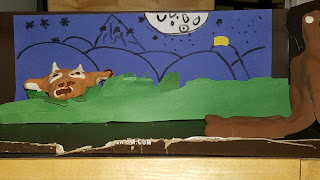 Before we started, we discussed the importance of setting to a story. We read Dogteam by Gary Paulsen, a story of a dog sled ride through the woods on winter night. We found the words and phrases in the story that described the setting and helped to convey the feel of the ride. The students then shifted their attention to Where the Mountain Meets the Moon. Since this is a chapter book, we discussed how the images we see in our mind are similar but still different. In this way the book, like all stories, is a unique and personal experience. The students then chose a scene from the story they could clearly visualize in their head and set to work recreating the scene in the shoebox.
Before we started, we discussed the importance of setting to a story. We read Dogteam by Gary Paulsen, a story of a dog sled ride through the woods on winter night. We found the words and phrases in the story that described the setting and helped to convey the feel of the ride. The students then shifted their attention to Where the Mountain Meets the Moon. Since this is a chapter book, we discussed how the images we see in our mind are similar but still different. In this way the book, like all stories, is a unique and personal experience. The students then chose a scene from the story they could clearly visualize in their head and set to work recreating the scene in the shoebox.Right away it was obvious the different skills this project demanded. Students had to problem solve differently. Instead of seeking and finding different parts of a program they had to create from scratch using paper, scissors, glue and clay. They could not choose from a vast array of colors, they had to find ways to develop the colors in the clay. What colors and how much do you add to get the exact shade you need? What happens when you have limited materials and you make a mistake? When
working digitally there is much more room for error, for discarding something that didn't work. When working with physical materials, we needed to discuss conserving, sharing and adapting when there is a mistake. Digitally we can bring in images that we don't create, but rather use something someone else created. In this project every aspect was created by hand. For some, who maybe struggled with fine motor skills, this was more challenging. And yet, not one student complained, disengaged, or asked someone else to do it for them.
 Some aspects of the process were very similar to working with computers. Although each student was creating their own diorama, there was a sharing of ideas, of technique and much discussion on how to create a certain vision. In this way, the collaborating and group problem solving was the same as when the students work with technology. Although there was some roaming as students checked out each other's work, mostly students were absorbed in their own process or stuck with the students near their own work space.
Some aspects of the process were very similar to working with computers. Although each student was creating their own diorama, there was a sharing of ideas, of technique and much discussion on how to create a certain vision. In this way, the collaborating and group problem solving was the same as when the students work with technology. Although there was some roaming as students checked out each other's work, mostly students were absorbed in their own process or stuck with the students near their own work space.For me, this was a reminder that technology is awesome and students love to work on computers.
And, there is legitimate value to working off computers and working in the throwback project.


No comments:
Post a Comment